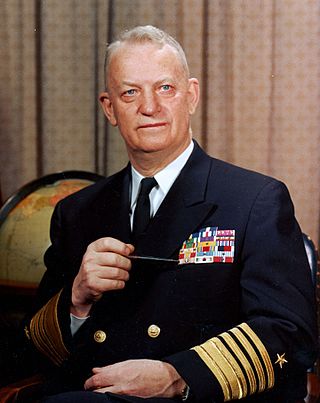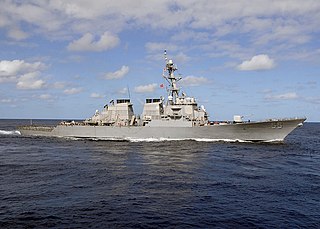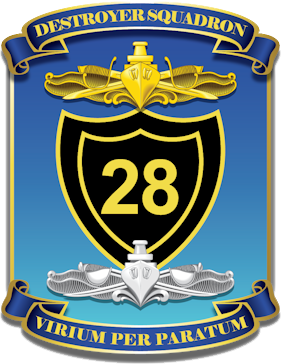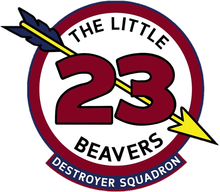
The Arleigh Burke class of guided-missile destroyers (DDGs) is a United States Navy class of destroyer centered around the Aegis Combat System and the SPY-1D multi-function passive electronically scanned array radar. The class is named for Admiral Arleigh Burke, an American destroyer officer in World War II and later Chief of Naval Operations. With an overall length of 505 to 509.5 feet, displacement ranging from 8,300 to 9,700 tons, and weaponry including over 90 missiles, the Arleigh Burke-class destroyers are larger and more heavily armed than many previous classes of guided-missile cruisers.

Arleigh Albert Burke was an admiral of the United States Navy who distinguished himself during World War II and the Korean War, and who served as Chief of Naval Operations during the Eisenhower and Kennedy administrations.

Bath Iron Works (BIW) is a major United States shipyard located on the Kennebec River in Bath, Maine, founded in 1884 as Bath Iron Works, Limited. Since 1995, Bath Iron Works has been a subsidiary of General Dynamics, one of the world's largest defense companies. BIW has built private, commercial, and military vessels, most of which have been ordered by the United States Navy.

USS Boone (FFG-28) was the twentieth ship in the United States Navy's Oliver Hazard Perry-class of guided missile frigates.

USS Barry (DDG-52) is an Arleigh Burke-class guided missile destroyer, commissioned in 1992. Barry is the fourth United States Navy ship named after the "Father of the American Navy", Commodore John Barry (1745–1803). Her homeport is Naval Station Everett, Washington. Several improvements over Arleigh Burke exist on this ship and all following Arleigh Burke-class destroyers, such as the ability to refuel a helicopter.

USS John Paul Jones (DDG-53) is the third Arleigh Burke-class guided missile destroyer in the United States Navy and the first ship of the class homeported on the west coast. She is the fifth ship named after American Revolutionary War naval captain John Paul Jones and the second to carry his first name. She was built at Bath Iron Works in Bath, Maine. The ship is part of Destroyer Squadron 9 of Carrier Strike Group 11, which is headed by the nuclear-powered aircraft carrier USS Nimitz (CVN-68).

USS Stout (DDG-55) is the fifth Arleigh Burke-class guided missile destroyer. Built for the United States Navy by Ingalls Shipbuilding, she was commissioned on 13 August 1994 and she is currently home-ported in Naval Station Norfolk. She is part of Destroyer Squadron 28. Stout is named for Rear Admiral Herald F. Stout, who distinguished himself as the commanding officer of the destroyer USS Claxton during World War II. In November 1943, Commander Stout received two Navy Crosses in the span of three weeks for his actions in the Pacific. Stout aided Destroyer Squadron 23 in sinking five heavily armed Japanese warships and damaging four others during the Solomon Islands campaign as well as sinking four more Japanese warships and damaging two others to establish a beachhead on Bougainville Island. Stout was ordered on 13 December 1988, the keel was laid down on 8 August 1991, she was launched on 16 October 1992 and commissioned on 13 August 1994. As of January 2024 the ship is part of Destroyer Squadron 28 based out of Naval Station Norfolk.
A destroyer squadron is a naval squadron or flotilla usually consisting of destroyers rather than other types of vessel. In some navies other vessels, such as frigates, may be included. In English the word "squadron" tends to be used for larger and "flotilla" for smaller vessels; both may be used for destroyer units. Similar formations are used in non-English-speaking countries, e.g., the "escadrille"—which would translate directly as "squadron"—in France.

The Commander, Naval Surface Force, Atlantic (COMNAVSURFLANT) is a post within the United States Fleet Forces Command. As Naval Surface Force Atlantic, it is a military formation, and the organization is often known as SURFLANT. Its headquarters are at Naval Station Norfolk in Norfolk, Virginia. The current commander is Rear Admiral Brendan R. McLane. COMNAVSURFLANT supervises all surface ships based on the Eastern United States and Gulf Coast of the United States, as well as ships forward deployed to Naval Station Rota, Spain.

USS Michael Murphy (DDG-112) is the 62nd ship of the Arleigh Burke class of guided missile destroyers in the United States Navy. She is named for Medal of Honor recipient Lieutenant Michael P. Murphy (1976–2005). Murphy was posthumously awarded the Medal of Honor for his actions during Operation Red Wings in Afghanistan in June 2005. He was the first sailor awarded the Medal of Honor since the Vietnam War. The ship's name was announced by Secretary of the Navy, Donald C. Winter on 7 May 2008. The ship was christened on 7 May 2011, Murphy's birthday, by her sponsor Maureen Murphy, Michael Murphy's mother. The ship is part of Destroyer Squadron 31 of Naval Surface Group Middle Pacific.

Destroyer Squadron ONE, also known as Destroyer Squadron 1 and often abbreviated at DESRON ONE or DESRON 1, is a squadron of warships of the United States Navy. It is an operational component of Carrier Strike Group One and is administratively responsible to Commander, Naval Surface Forces Pacific.

Samuel Perez Jr. is a retired rear admiral in the United States Navy.

Rear Admiral Jesse Alphonzo Wilson Jr. is a retired United States Navy officer. His last active duty assignment was as commander of Naval Surface Force Atlantic.

Destroyer Squadron 7 is a naval unit of the United States Navy stationed in Singapore. It is assigned to the United States Seventh Fleet.

Destroyer Squadron 15 is the largest Destroyer Squadron in the United States Navy consisting of nine Arleigh Burke-class destroyers forward deployed to Yokosuka, Japan. Commander, Destroyer Squadron 15 also serves as Commander, Task Force 71 which includes command and control of independent Cruiser and Destroyer deployments, U.S. Coast Guard deployments, and a host of Allied and partner Navy surface Combatant deployments to the Western Pacific.

Destroyer Squadron 26 (DESRON-26) is a destroyer squadron of the United States Navy. It was first created in 1950. It has seen action in the Korean War, service in the Atlantic, in the Vietnam War. From 1974 for a period it became the 'Mod Squad', trialling ships commanded by officers one rank junior to the usual appointment rank.

USS Daniel Inouye (DDG-118) is an Arleigh Burke-class destroyer in the United States Navy. She is named to honor former United States Senator Daniel Inouye of Hawaii. Inouye was awarded the Medal of Honor for his actions in Tuscany, Italy, during World War II. She is part of Destroyer Squadron 31 of Naval Surface Group Middle Pacific.

Destroyer Squadron 60 is a destroyer squadron of the United States Navy. Destroyer Squadron 60 is one of three U.S. Navy destroyer squadrons permanently based outside the continental United States.

Destroyer Squadron 28, is a squadron of warships of the United States Navy. It is an operational component of Carrier Strike Group Eight. The squadron was formed in 1951. DESRON 28 was re-established on 1 September 1995, during the most recent reorganization of the Atlantic Fleet surface force. The mission of DESRON 28 is to provide a fully trained, combat ready force of surface combatants.

Destroyer Squadron 50 is a destroyer squadron of the United States Navy. The squadron was first formed during World War II when the squadron commodore and his staff led ships in the Pacific Theater from October 1943 until its disestablishment in November 1945. The squadron was equipped with nine Fletcher-class destroyers, comprising Destroyer Divisions (DesDivs) 99 and 100.




















